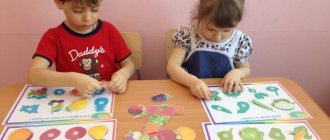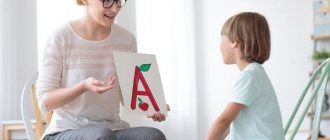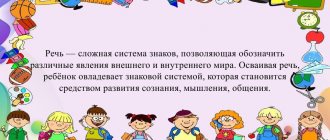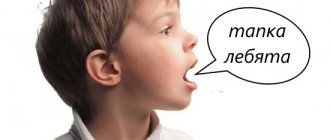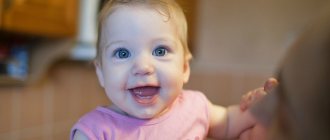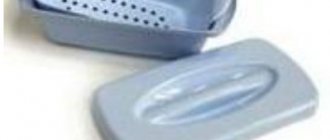I have been using bioenergoplasty in speech therapy classes for more than five years. I will be happy to share my experiences on this topic. For each traditional articulation exercise, I selected hand movements (movements that imitate the position of the articulation organs). And to make it more interesting for children to do the exercises, I use poems, fairy tales adapted by me by V. Suteev, S. Prokofieva, I. Pivovarova and other authors for bioenergoplasty classes (the storylines in them are preserved, but the characters are selected in accordance with the names of the exercises).
Bioenergoplasty exercises
“Chicks” Palm in a vertical position. The thumb is placed forward, perpendicular to the rest.
“Spatula” The palm with closed fingers is lowered down.
“Cup” The palm with bent fingers forms a cup shape.
“Needle” The fingers are clenched into a fist, the index finger is pointed forward.
“Pussy is angry”, “slide” Fingers are closed, palm is bent.
“Watch” Palm clenched into a fist. The index finger is raised up. As you count, the hand turns left and right.
“Snake” The palm is clenched into a fist. As you count, the palm with closed fingers straightens, then contracts again, moving back and forth.
“Swing” Palm with closed fingers in a vertical position. Movement of the palm down and up.
“Football” The palm is clenched into a fist. Index finger in front. The index finger, together with the hand, rotates left and right.
“Brush your teeth” The palm is clenched into a fist, the index finger is extended forward. The index finger moves in a circle.
“Horse” Hand in a horizontal position (lying on the table). The palm with closed fingers is bent. To count, touch the table alternately with your fingertips and wrist.
“Delicious jam” Cup-shaped palm. Bend and straighten closed fingers.
“Smile” The palm is in a vertical position, the fingers are widely spaced.
“Fence” The palm is in a vertical position, the fingers are closed.
“Tube” The palm with bent fingers forms a tube.
“Proboscis” The palm is clenched into a fist.
“Punish a naughty tongue” In a horizontal position, four fingers are closed, the thumb is pressed to the middle one. Perform quick taps of the thumb on the middle finger.
“Let’s brush our teeth” Bent palm with closed fingers. The palm straightens and bends again. Then the bent palm moves left and right.
“Who will kick the ball further?” The hand is palm down in a horizontal position. As the cotton wool moves across the table, the palm moves forward.
“Focus” The palm is clenched into a fist. When the cotton wool flies up, the fingers are unclenched and spread apart.
“Glue the candy” The brush is in a horizontal position, palm up. Fingers closed. The brush goes up and then down.
“Mushroom” The hand of one hand is positioned vertically, the hand of the other is located horizontally on the hand of the first hand.
“Accordion” The hand lies on the table, palm down. During the lowering and raising of the lower jaw, the hand with closed straight fingers lowers and rises.
“Turkey”, “Chatterer” Four fingers are closed, the thumb is pressed to the index finger. Four fingers make quick up and down movements.
“The steamer is humming” The palm with closed fingers is positioned horizontally.
“The plane is humming” The palm with fingers spread is positioned horizontally.
“Painter” The palm is positioned vertically, the fingers are closed. Movement of the palm back and forth.
“Woodpecker” The fingers of one hand are closed and slightly compressed, knocking on the palm of the other hand.
MBDOU "Podporozhye kindergarten No. 4 combined type"
It's no secret that the number of children with disabilities is currently growing, including children with SLD. And therefore, for us, specialists - speech therapists, the creation of an optimal system of comprehensive assistance to children with STD in mastering the preschool education program and positive social adaptation to the next age level - school, is of particular relevance.
Organizing the activities of children with speech disorders requires a special approach. Often, neither the desire of a speech therapist nor the knowledge of speech correction techniques is enough to obtain the desired result when correcting speech deficiencies. Therefore, specialists are forced to look for the most effective ways of education and training.
It is known that the use of various non-traditional methods and techniques by speech therapists in their work supports the child’s cognitive activity, prevents fatigue, and, in general, increases the effectiveness of speech therapy work. And one of these methods is bioenergoplasty.
Bioenergoplasty is a combination of movements of the organs of the articulatory apparatus with movements of the hands and fingers.
In speech therapy practice, a significant role is played by the development in children of kinesthetic sensations of the organs of articulation, which allow them to feel the different positions of the organs of the articulatory apparatus.
And the use of a method such as bioenergoplasty helps specialists develop these sensations in children.
This method is advisable to use in speech therapy practice, since by developing fine motor skills and thereby activating the corresponding parts of the brain, we activate neighboring areas responsible for speech.
Research by domestic physiologists (Marionilla Maksimovna Koltsova, Vladimir Mikhailovich Bekhterev, Alexey Alekseevich Leontyev) confirms the positive effect of fine movements of the fingers on the functioning of the speech zones of the cerebral cortex.
The basic principle of bioenergoplasty is the conjugate work of the hands, fingers and articulatory apparatus, where hand movements imitate the movements of the speech apparatus.
Corrective work using the “Bioenergoplasty” method arouses children’s interest in speech therapy classes. When teaching children, the speech therapist uses various game characters, gloves, counting, music, poetry, and presentation materials.
Each speech therapist can develop an acceptable set of exercises aimed at producing sounds of different groups using the “Bioenergoplasty” method. Exercise sets may vary in complexity depending on the age of the children. It is also possible to use elements of bioenergoplastics as warm-ups and physical exercises in any type of activity. The proposed method can be used by educators in correctional work.
Complex of articulatory gymnastics,
aimed at producing whistling sounds using the “Bioenergoplastika” method
When performing exercises, children sit on chairs opposite the speech therapist. The children's arms are spread to the sides, elbows bent. Each exercise is performed for 6 - 8 seconds. After completing each exercise, children are asked to lower their hands and relax.
Exercise for the tongue “Hippopotamus” - the exercise is accompanied by squeezing and unclenching the hands;
Exercise for the tongue “Smile” - fingers clenched into a fist;
Exercise for the tongue “Tube” - fingers closed, extended forward;
Alternate exercises “Smile” and “Pipe” 2-3 times.
Exercise for the tongue “Shovel” - the hands are relaxed and lowered;
Exercise for the tongue “Groove” - the hands take the shape of a “boat” (fingers are closed, slightly bent, fingertips are adjacent to each other);
Exercise for the tongue “Slide” - the hand takes the shape of a slide;
Alternate exercises “Groove” and “Slide” 2-3 times.
Speech material on bioenergoplasty
"The Bee and the Wasp"
Once upon a time, the Wasp and the Bee lived together in the forest. Their house was in a hollow tree. (exercise “Woodpecker” - a woodpecker hollows out a hollow) The bee flew in the field all day long and collected honey. The Bee will wake up early in the morning, smile at the new day, (exercise “Smile”), wash his face, brush his teeth, do exercises, (exercise “Brush my teeth”) look at his watch and fly into the field. (exercise “Clock”) With the help of her proboscis, the Bee collected honey. (exercise “Proboscis”) And when Osa woke up, she drank tea (exercise “Cup”) with sweets, (exercise “Glue the candy”) ate pancakes (exercise “Spatula”) with aromatic, delicious honey. (exercise “Tasty Jam”) All day long, the Wasp swung on a swing (exercise “Swing”) and chatted with other wasps. (exercise “Turkey”, “Chatterer”) In the evening, a tired Bee flew home and worked again. She sewed clothes, (exercise “Needle”) painted the walls and ceiling in the house. (exercise “Painter”) And in the morning she flew into the field again. One day the Bee returned from the field, and the Wasp said to her: “You didn’t bring enough honey, fly back.” The Bee got offended and left the house. She flies and cries. A Man saw her: “Are you crying, Bee?” “And now I have nowhere to live,” says the Bee, “I left home.” - Don’t cry, Bee, I’ll build you a new house... The Man built a wooden house for the Bee in his garden, and since then the Bee has lived in a comfortable hive. And he pays Man good for good—he treats him with honey. (exercise “Delicious jam”)
"Under the mushroom." One day a Mosquito was flying (exercise “Proboscis”) and it began to rain heavily. (exercise “Woodpecker”) Where to hide? The Mosquito saw a small fungus in the clearing, (exercise “Mushroom”) flew to him and hid under his hat. Sits under a fungus, waiting out the rain. And the rain comes harder and harder. Sparrow jumps past the mushroom and cries. (exercise “Chicks”) - The feathers are wet, the wings are tired. Let me, Mosquito, dry out under the fungus and wait out the rain! -Where should I let you go? I somehow fit in here alone. -Nothing, in cramped conditions, but not offended. Mosquito let Sparrow under the fungus. The snake crawls towards the mushroom. (exercise “Snake”) Requests: - Let it go under the fungus, wait out the rain. - There's no room here. - Move over, please. We moved, there was a place for the snake. The Hedgehog runs to the mushroom (exercise “Needle”) and asked to wait out the rain and they let him in. And the rain keeps pouring and doesn’t stop. (exercise “Woodpecker”) The Bunny is jumping. (exercise “Horse”) - Hide, - shouts, - save! Fox is chasing me! “It’s a pity for the Hare,” says the Mosquito, “let’s make room some more.” As soon as they hid the Hare, the Fox came running. (exercise “Pussy is angry”) - Have you seen the hare? - asks. - Did not see. Lisa came closer. “Isn’t this where he hid?” - Where can he hide here? The Fox waved her tail and left. By that time the rain had passed and the sun came out. Everyone crawled out from under the mushroom and rejoiced. The mosquito thought for a moment and said: “How can this be?” Previously, it was cramped for me alone under the mushroom, but now there was a place for all five of us. - Kwa-ha-ha! Kwa-ha-ha! – someone laughed. Everyone looked: a Frog was sitting on a mushroom cap and laughing: (exercise “Smile”) - Oh, you! Mushroom... She didn’t finish saying it and galloped away. We all looked at the mushroom and then guessed why at first it was cramped for one under the mushroom, and then there was room for five. Have you guessed it?
"Cuckoo-clock". Early morning. The inhabitants of the fairy-tale town are sleeping. There is a clock tower in the town square. A Cuckoo lives in a small house above the clock. Tick tock! - the pendulum ticks time. Cuckoo! - Cuckoo looked out. (exercise “Clock”) The Dog woke up and began to get ready for work. He's a painter. (exercise “Painter”) Today he needs to paint a beautiful carved fence around the town. (exercise “Fence”) In her cozy house, the Cat put the pie in the oven. (exercise “Pussy is angry”) Pie with filling: with strawberry jam. (exercise “Delicious jam”) “Everything must be done by the clock,” says the Cat to the Kittens. “The Cuckoo crows again, which means it’s time to take out the pie.” The cheerful Frog started cleaning in time. (exercise “Smile”) Every morning he washes his raft with a brush. (exercise “Let’s brush our teeth”) Time passes, but the Cuckoo remains silent. All the residents of the town gathered in the square. The doors of the house are closed, there is a note hanging: “Gone into the forest.” “Nonsense,” said the Frog. - Anyone can be a cuckoo. Now I will be the Cuckoo,” and jumped into the house above the clock. The sun rose high. The little frog felt hot. - No, I can’t be Cuckoo. “Then I’ll be the Cuckoo,” said the Cat. - Meow meow! Then she curled up into a ball and fell asleep. And in the Cat’s house a pie was burning (exercise “Spatula”) then the house caught fire. Okay, Little Frog used a hose to hose down the burning house. “No, now I’ll be the Cuckoo,” said the Dog. – I’ll just check the mechanism to see if everything is in order. The Dog hit the wheel with a hammer and the clock stopped altogether. The animals looked at each other in confusion. - Why couldn’t any of us become the Cuckoo? - asked the Cat. “Yes... Apparently, every task must be done skillfully,” the Dog lowered his head guiltily. Then everyone saw the Cuckoo and were very happy. (exercise “Smile”) The cuckoo quickly fixed the clock and crowed: - Ku-ku! Cuckoo! (exercise Clock”) And everything in the fairy-tale town went as usual.
"Visiting Sunny." One day a large cloud covered the sky. The chickens are bored without sunlight. (exercise “Chicks”) - Where did that Sun go? - They say. “We need to return him to heaven as soon as possible.” - Do you know where it lives? - Mother Hen cackled. “We don’t know, but we’ll ask whoever we meet,” answered the Chickens. The Mother Hen collected them for the journey. I put some delicious grains. (exercise “Delicious jam”) The chickens set off. They walked and walked and saw the Turkey. (exercise “Turkey”) They ask: “Turkey, do you know where Sunny lives?” - I don’t know, let’s look together. They walk past the forest and see a woodpecker sitting on a tree and hollowing out a hollow. (exercise “Woodpecker”) They asked the Woodpecker about Sunny, but the Woodpecker also doesn’t know where Sunny lives. Let's all go look together. The Horse galloped past and also went with them to look for the Sun. (exercise “Horse”) They walked for a long time. We saw the Hedgehog. (exercise “Needle”) He sat under a tree and played the accordion. (exercise “Accordion”) - Hedgehog, Hedgehog, do you know where Sunny lives? - the Chickens ask. “He wasn’t in heaven for three days, didn’t he get sick?” - How not to know. I know, over there, behind the big mountain. – Hedgehog answered. (exercise “Gorka”) Hedgehog took a stick, strung mushrooms on needles and walked ahead of everyone to show the way. (exercise “Mushroom”) Chickens, Turkey, Woodpecker, Horse and Hedgehog climbed the mountain and saw the sun’s house. And the house is dark, there is no light, he fell asleep, it’s clear that Sunny doesn’t want to wake up. Then the chickens squealed, the turkey chattered, the woodpecker knocked, the horse neighed, the hedgehog snorted. - Who is screaming under my window? – asked the Sun. - Who doesn’t bother me to sleep? - This is us. We've come to wake you up. Morning has come. - How can I look at the sky? For three days the cloud hid me, for three days it obscured me. Now I won’t even be able to sparkle... The horse took a bucket and began to carry water. (exercise “Cup”) Woodpecker - Wash the sun with water. Turkey - wipe with a towel. (exercise “Painter”) Hedgehog - let’s clean it with the prickly bristles. (exercise “Swing”) And the Chickens began to brush away the specks from the Sun. (exercise “Focus”) The sun looked out into the sky, clean, clear and golden. And everywhere it became fun, light and warm. (exercise “Smile”)
"Rooster and paints." The Artist drew a Rooster (exercise “Chicks”) but forgot to color it... The Rooster went for a walk, and everyone in the yard suddenly began to laugh. - Why are they laughing at me? - asked the Turkey Rooster. (exercise “Turkey”) “You’re walking around completely unpainted,” said the Turkey, “look at yourself!” The Rooster ran up to the puddle and looked into the water. And that’s right - Turkey is telling the truth. The Rooster was completely upset. Then the Cat came up. (exercise “Pussy is angry”) “Don’t be sad,” said the Cat, “go to the Paints, they will help you.” (exercise “Painter”) - Ku-ku-da to the Paints? - the Rooster clucked. – Where can I find them? “I’ll teach you,” said the Cat. - Walk straight and straight all the time, don’t turn anywhere. You will go through forests, go through mountains, through rivers and lakes you will come to a Fairy Tale and there you will find Colors! And the Cockerel went to look for Paint. The Rooster is walking through the forest. And in the clearing the little foxes were playing with a ball. (exercise “Who will kick the ball further?”) The little foxes noticed him and shouted: “Mom, mom!” Look - Rooster! At this time the fox was punishing one of the cubs. (exercise “Punish a naughty tongue”) The Fox saw the Rooster and turned away. - No, no... This Rooster is no good. He is unpainted. This is a fake Rooster! And the Cockerel kept walking and saw the Hedgehog. (exercise “Needle”) The Hedgehog showed the Cockerel where the Colors live. The Rooster came to a painted little house, around which there was a multi-colored fence. (exercise “Fence”) - Ku-ka-re-ku! - Who's there? - they asked outside the door. - It's me, Rooster. We went out to meet the Rooster of Colors and painted him in different colors. Red Paint painted the comb and beard, Blue Paint the feathers on the tail, Green Paint the wings, and Yellow Paint the breast. (exercise “Painter”) The Cockerel looked in the mirror - he didn’t recognize himself! It has become so beautiful! The Rooster thanked the kind Colors, smiled (exercise Smile) and walked home cheerfully. Sings to the whole forest: - Ku-ka-re-ku! The little foxes were now swinging on a swing, (exercise “Swing”) they saw him and squealed: “Mom, look, the rooster is coming back!” “I told you, it’s not real, it’s not painted.” - Mom, he's real! A real, live Rooster! The Fox wanted to catch up with the Rooster, but realized it too late: he had already gone far...
Master class “Use of bioenergoplastics in the work of a preschool teacher-speech therapist”
Master class
of a speech therapist teacher
at MBDOU
" Kindergarten" No. 2 "Golden Key" in the village of Energetik,
Novoorsky district, Orenburg region
Troneva Svetlana Vasilievna
“The use of bioenergoplastics in the work of a speech therapist”
Sound pronunciation disorders are the most typical speech disability in the majority of future first-graders. Disadvantages of sound pronunciation in a child’s subsequent life can cause: deviations in the development of mental processes, can lead to academic failure, provoke the formation of an inferiority complex, expressed in difficulties in communication, which will have far-reaching negative consequences. Timely elimination of pronunciation deficiencies will help prevent difficulties in mastering reading and writing skills. Working on the formation of correct sound pronunciation in children is a very complex and lengthy process, consisting of several stages, the main of which is ARTICULATION GYMNASTICS. And so that interest in this type of activity does not decrease, we combined it with bioenergoplastics. This helps maintain a positive emotional mood of the student and teacher, helps increase children’s motivational readiness for classes, and helps maintain the child’s interest for a long time. Bioenergoplasty is a combination of movements of the articulatory apparatus with movements of the hand. Body movements, joint movements of the hand and the articulatory apparatus, if they are plastic, liberated, and in systems for the development of intelligence using kinesiology methods (massage of the hands, neck, shoulders, finger motor skills, articulatory gymnastics). This is another argument in favor of the use of bioenergoplasty, since under the influence of kinesiological training, positive structural changes in the body are noted: the work of the cerebral hemispheres is synchronized, abilities develop, memory, attention, thinking, and speech improve. Strength, balance, mobility and plasticity of nervous processes are carried out at a higher level. For the correctional work of speech therapists, the most significant is the combination of bioenergoplasty with the movements of the organs of the articulatory apparatus. When performing an articulation exercise, the hand shows where and in what position the tongue, lower jaw or lip is located. The need to use fingers is due to impaired finger motor skills, incoordination of movements of the organs of articulation, and impaired kinesthetic sensations of the position of the tongue, lips, and lower jaw.
Bioenergoplasty allows you to quickly remove the visual support - the mirror - and move on to performing exercises based on sensations. This is especially important because in real life children do not see their articulation. Bioenergoplasty should be an integral part of speech therapy work, both for the development of the articulatory apparatus, speech breathing and the complex: speech and movement, as well as for emotional and mental balance and perfection.
The introduction of a system of games and exercises in bioenergoplastics
involves several stages:
Stage 1 – Diagnostic.
It determines the structure of the defect, its clinical manifestations and ways of correction. Stage 2 - Emotional.
His main task was to establish a trusting relationship with the child, create a positive emotional mood, and arouse interest in activities. Having studied the methods of a number of authors on this issue (A.V. Yastrebova, O.I. Lazarenko, etc.), we developed special movements of the hands and fingers for each articulation exercise, came up with heroes of the glove theater, the names of which depend on the sounds that we we teach with children, as well as the names of heroes for different sounds, we come up with fairy tales for them - the journeys of these heroes, depending on the tasks. Stage 3 - Main
At this stage, children perform exercises with a speech therapist. Until the hand turns on. These exercises start from September. Next, articulation exercises are performed using the child’s leading hand with a glove. The speech therapist also performs the exercise together with the child, accompanying the exercises by showing the dominant hand. Next, the child’s other gloved hand is involved in articulation exercises. The teacher-speech therapist also accompanies the performance of articulation exercises and hand movements. The period when the child has fully mastered the exercises and can perform them independently. And the teacher-speech therapist accompanies the child’s exercises by telling a fairy tale. This kind of finger-speech gymnastics is performed throughout the school year. The teacher monitors the rhythmic execution of the exercises. Then you can use a shadow theater, tabletop, or finger theater. etc. Classes can be conducted individually or with a subgroup of two or three children. Different stories are told - the journeys of heroes, scenery is used. The teacher acts as a storyteller, the children perform movements with their hands and tongue. The mirror is gradually removed.
P
examples of basic exercises.
Depending on the chosen fairy tale, the name of the exercise (hero) may change. Children quickly switch and get involved in a new game. Further, all exercises can be combined into a single plot.
P
example of a fairy tale.
"Trip to the Zoo"
Bioenergoplasty exercises
1. Vegetable garden
(author's work).
| We took our shovels (articulation exercise: “Spatula” - hold + put your hands palms up) The beds were quickly dug up (“Spatula” + hand movements simulating digging). And then we took the rake (exercise: “Painter” + showed hands - “rakes” (bending and spreading fingers) They leveled their beds (“Painter” + raking with “rakes” - hands). We plant the seeds (Exercise “Swing” + make a pinch of three fingers - imitate planting seeds), Let's get a full harvest (“Bubble” - puff out our cheeks + spread our arms to the sides). |
2. Autumn
.
We walk - we wander alone - autumn is nearby. somewhere (“Swing” + with the index and middle fingers we imitate walking on the table).
Yellow leaf on the water - where are you, our summer? (“Spatula” + hands with palms down – make smooth movements),
We take a leaf in our hands - what if it’s the very last one? (Biting the tip of the tongue with your teeth, hold it + with three fingers, as if, take a piece of paper and make movements with your hands - from side to side),
We welcome autumn into the circle, hello autumn day (sticking your tongue out of your mouth - make circular movements + circular movements with your hands).
3. Harvest.
Joyfully, like in the garden (“Frog” - wide smile + index fingers - show a “smile” - (͜),
Work on a warm day (“Lazy tongue” + clench – unclench your fists).
A bright ray walks across the beds, the black soil smells wonderful (“Snake” with the tongue + index and middle fingers - imitate walking on the table).
Everything has grown and ripened (“Coil” + alternate movements of the fingers (from top to bottom) - we imitate the growth of plants),
The harvest will be rich (“Nut” + spread our arms to the sides).
For all of us - there is something to do - we collect the harvest (“Swing” + we imitate picking fruits from a tree with our hands).
4. Birds.
Our birds were starving (we bite the tip of our tongue and, at the same time, open and close a pinch of our hand).
And they looked for food everywhere ( “Watch + straight palms (away from us) - swing them from side to side - like a pendulum).
Like this, like this - and they looked for food everywhere.
We wintered, roamed, flew around, checked everything (“Painter + flapping our arms like wings”).
Like this, like this - they picked berries from the trees (Smile - elephant + imitate picking berries).
In a thicket they hollowed out a tree and found insects (“Woodpecker: d-d-d..+ fist on fist”).
Like this, like this: insects were found.
They lived next to us (“Nut” + one palm at the chest, the other hand forward).
Together the crumbs finished eating (“Delicious jam” + a pinch, like a bird’s beak - knocking on the feeder).
Like this, like this - the crumbs were finished eating together.
5. Winds.
High peaks, the winds are still sleeping (“Mushroom” + raise our hands up),
Only the leaves of the trees rustle (“hiss” - shhh + with open palms we make smooth movements),
They whisper quietly, talking to each other (“Frog” - “Elephant” + pinches of hands touching each other with fingertips).
The ringing rain is pouring down on the elastic branches (“Nut” + fingering the hands to imitate the falling of raindrops).
6. Winter.
They lead a cheerful round dance, white snowflakes (“Horse” + fingers on hands - together - apart),
A blizzard flies across the fields, along a wide path (“Watch” + with our palms we make smooth movements from side to side),
The moon came out from behind the clouds, a round hump (“Accordion” + showing a circle with the index and middle fingers).
It hangs high, with a bright toy (“Cup” + raise your hands up).
7. Bumblebee.
I am a nice furry bumblebee, I woke up in April (“Needle” + waving our arms, imitating the movements of our wings),
With ringing streams, bright rays (we say “Ding - ding” + clench - unclench our fists - spreading our fingers, imitating the rays of the sun).
And I fly and buzz, I circle over the forest (“Watch” + we wave our palms - up - down),
I’ll pick up a red flower, I’ll drink the fragrant juice (“Elephant Smile” + with three fingers (a pinch) of both hands – we “take” the flower and bring it to our lips one by one).
Thus, the use of articulatory gymnastics with bioenergoplasty helps to attract children’s interest in performing exercises, which significantly increases the effectiveness of articulatory gymnastics, promotes the development of finger motor skills, the development of all mental processes, the articulatory apparatus, which greatly facilitates the formulation and introduction of sounds into speech, and also improves emotional children's attitude and self-confidence. The work carried out proves the feasibility of using bioenergoplastics for children with speech impairments, especially in the group work of preschool educational institutions.
